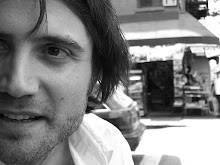
One of the biggest reasons I started this blog was to promote new music that I feel might not be getting the attention that it deserves. I previously wrote about my good friend David Doruzka's recent release of poetry settings, which was a staple of my summer listening, and now wish to spotlight saxophonist and composer Rob Mosher's new release with his group Storytime, entitled The Tortoise
, which I so curiously happen to play on.
Until he called me to play one of his open rehearsals at the Brooklyn Lyceum, Rob was unknown to me. He moved here from Toronto in 2004 and somehow our paths had never crossed. Clearly something big has been brewing inside of him since he got here and is probably part of the reason somebody of his talent has existed largely under the radar here. Storytime is a ten-piece ensemble that consists of four wind players (including Rob on soprano saxophone and double reeds), trumpet, french horn, trombone, guitar, bass, and drums. Not quite a big band, but neither a small group, it functions somewhere in the middle, in what some might call chamber-jazz, and offers a myriad of orchestral colors while remaining intimate and quite often subdued.
The tracks on the record are through-composed, and range typically from five to ten minutes in length. None of them ever fall into the typical head, solo, head out format of jazz. Solos emerge out of nowhere, and are brilliantly worked into the ensemble. Despite a beautiful lyrical sense to his melodies, so many of them are indistinct in themselves, small kernels from which everything else emerges. Rather than blow the mystery of the compositional process the way most jazz composers do by giving you the hook upfront and relying on predictable devices (bass ostinatos, odd time signatures, angular melodies, etc.), Rob's pieces unfold slowly, with the patience of somebody much older than Rob. Little motives emerge as the pieces unfold, and appear subtly throughout the instrumentation, tying the pieces together in a very disciplined, yet unexpected way. Much like the great impressionist composers who moved away from large sweeping melodies, Mosher takes the minimum amount of material at squeezes it until every possibility inside of it has been found. Despite the intimidation some might feel at the idea of chamber jazz, a joy permeates this music, even in some of the more tragic sounding moments on the album, and I really believe this record has a rare accessibility to listeners. There are several solos on the record that really knock me out, including one from saxophonist Peter Hess, trombonist Mike Fahie, and two from guitarist Nir Felder, who all soar above the ensemble. Rob makes some beautiful contributions on soprano saxophone (evoking his own brand of Wayne Shorter), but clearly shares the spotlight generously with the other members of the ensemble.
Several humorous miniatures offset the density of this record, and are beautifully worked into the program, offering contrast but always setting the tone for what's to follow. One of my favorite moments is the sudden emergence of a choir singing Latin gibberish on a piece called Sleepless Lullaby. It comes out of nowhere in an otherwise serious piece, but somehow feels totally natural despite its absurdity. None of us had any idea what he had in mind when he handed us a sheet of lyrics on the session and asked us all to sing, and to hear this emerge from something so seemingly silly is quite astonishing.
A CD like The Tortoise is the product of literally thousands of hours of difficult, soul-searching work. It's no wonder so few people know about Rob, as he has clearly had something profound on his mind since getting here, and is one of the most hard-working and dedicated people I know.
Storytime will be having a CD release concert on October 3rd. Here'sthe info:
* Friday, October 3rd, 7:30pm
* Third Street Music, NYC, 235 East 11th Street (near 2nd ave)
* No Admission, Limited Seating, CD's $15
Go to www.robmosher.com to hear clips of the CD and to get information on how to order it.








